BUSN20016 - Social Media's Impact on Brand & Customer Relationships
VerifiedAdded on 2023/03/30
|15
|3827
|489
Project
AI Summary
This research project critically examines the impact of social media on brand image and customer relationships, particularly within the Australian automobile industry. It identifies the research problem, establishes objectives, and formulates research questions aimed at evaluating the relationship between social media and customer relationship management and branding. The study justifies its relevance by highlighting a gap in understanding the specific impact on Australian automobile companies. A conceptual framework is developed based on a review of past literature, focusing on how social media influences brand image and customer relationships. Hypotheses are developed to test the positive impact of social media on both brand image and customer relationships. The proposed methodology includes a research approach, data collection, and analysis techniques, along with a timeline and budget for the research. The project anticipates providing insights into leveraging social media for improved customer engagement and brand development.
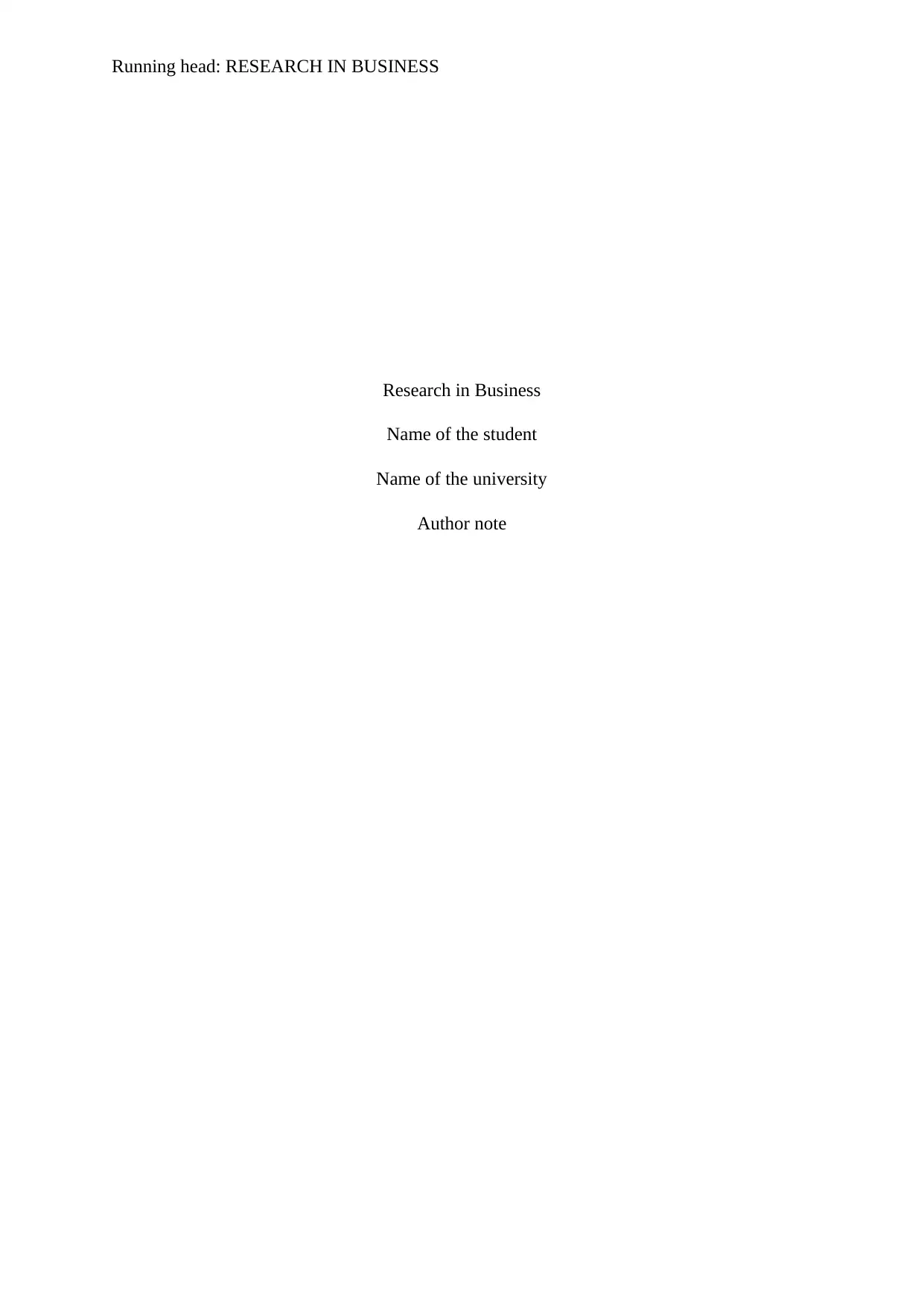
Running head: RESEARCH IN BUSINESS
Research in Business
Name of the student
Name of the university
Author note
Research in Business
Name of the student
Name of the university
Author note
Paraphrase This Document
Need a fresh take? Get an instant paraphrase of this document with our AI Paraphraser
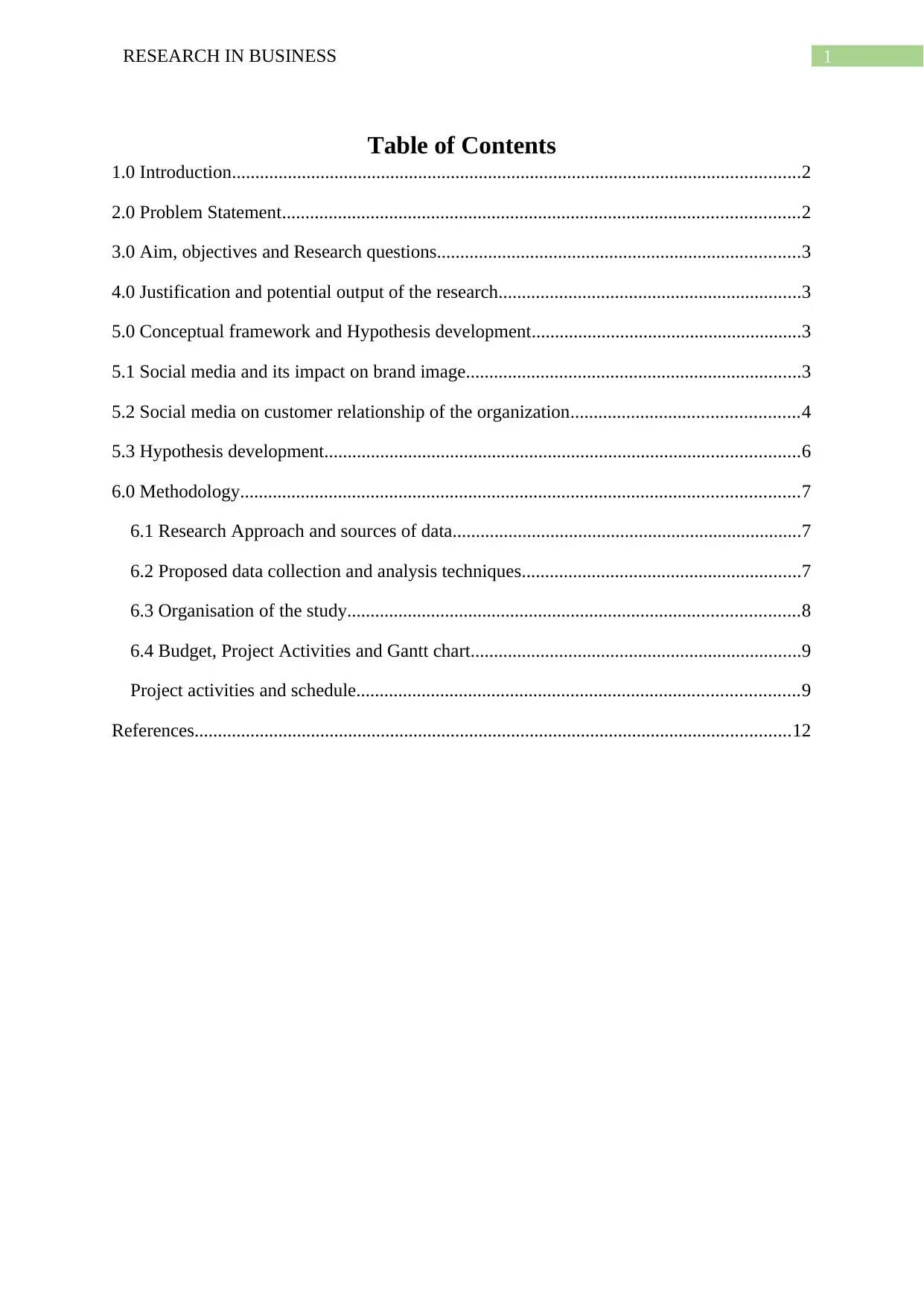
1RESEARCH IN BUSINESS
Table of Contents
1.0 Introduction..........................................................................................................................2
2.0 Problem Statement...............................................................................................................2
3.0 Aim, objectives and Research questions..............................................................................3
4.0 Justification and potential output of the research.................................................................3
5.0 Conceptual framework and Hypothesis development..........................................................3
5.1 Social media and its impact on brand image........................................................................3
5.2 Social media on customer relationship of the organization.................................................4
5.3 Hypothesis development......................................................................................................6
6.0 Methodology........................................................................................................................7
6.1 Research Approach and sources of data...........................................................................7
6.2 Proposed data collection and analysis techniques............................................................7
6.3 Organisation of the study.................................................................................................8
6.4 Budget, Project Activities and Gantt chart.......................................................................9
Project activities and schedule...............................................................................................9
References................................................................................................................................12
Table of Contents
1.0 Introduction..........................................................................................................................2
2.0 Problem Statement...............................................................................................................2
3.0 Aim, objectives and Research questions..............................................................................3
4.0 Justification and potential output of the research.................................................................3
5.0 Conceptual framework and Hypothesis development..........................................................3
5.1 Social media and its impact on brand image........................................................................3
5.2 Social media on customer relationship of the organization.................................................4
5.3 Hypothesis development......................................................................................................6
6.0 Methodology........................................................................................................................7
6.1 Research Approach and sources of data...........................................................................7
6.2 Proposed data collection and analysis techniques............................................................7
6.3 Organisation of the study.................................................................................................8
6.4 Budget, Project Activities and Gantt chart.......................................................................9
Project activities and schedule...............................................................................................9
References................................................................................................................................12
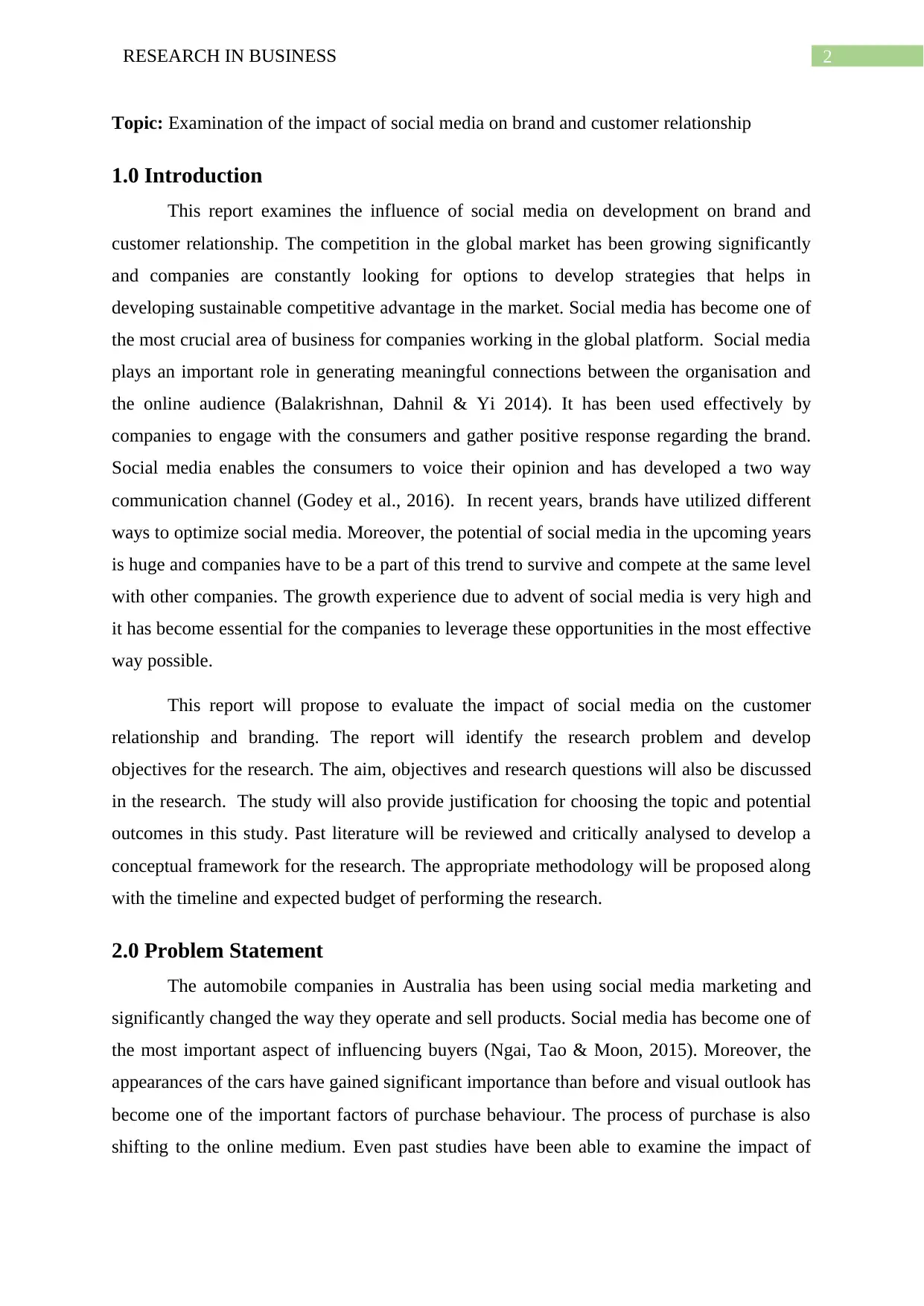
2RESEARCH IN BUSINESS
Topic: Examination of the impact of social media on brand and customer relationship
1.0 Introduction
This report examines the influence of social media on development on brand and
customer relationship. The competition in the global market has been growing significantly
and companies are constantly looking for options to develop strategies that helps in
developing sustainable competitive advantage in the market. Social media has become one of
the most crucial area of business for companies working in the global platform. Social media
plays an important role in generating meaningful connections between the organisation and
the online audience (Balakrishnan, Dahnil & Yi 2014). It has been used effectively by
companies to engage with the consumers and gather positive response regarding the brand.
Social media enables the consumers to voice their opinion and has developed a two way
communication channel (Godey et al., 2016). In recent years, brands have utilized different
ways to optimize social media. Moreover, the potential of social media in the upcoming years
is huge and companies have to be a part of this trend to survive and compete at the same level
with other companies. The growth experience due to advent of social media is very high and
it has become essential for the companies to leverage these opportunities in the most effective
way possible.
This report will propose to evaluate the impact of social media on the customer
relationship and branding. The report will identify the research problem and develop
objectives for the research. The aim, objectives and research questions will also be discussed
in the research. The study will also provide justification for choosing the topic and potential
outcomes in this study. Past literature will be reviewed and critically analysed to develop a
conceptual framework for the research. The appropriate methodology will be proposed along
with the timeline and expected budget of performing the research.
2.0 Problem Statement
The automobile companies in Australia has been using social media marketing and
significantly changed the way they operate and sell products. Social media has become one of
the most important aspect of influencing buyers (Ngai, Tao & Moon, 2015). Moreover, the
appearances of the cars have gained significant importance than before and visual outlook has
become one of the important factors of purchase behaviour. The process of purchase is also
shifting to the online medium. Even past studies have been able to examine the impact of
Topic: Examination of the impact of social media on brand and customer relationship
1.0 Introduction
This report examines the influence of social media on development on brand and
customer relationship. The competition in the global market has been growing significantly
and companies are constantly looking for options to develop strategies that helps in
developing sustainable competitive advantage in the market. Social media has become one of
the most crucial area of business for companies working in the global platform. Social media
plays an important role in generating meaningful connections between the organisation and
the online audience (Balakrishnan, Dahnil & Yi 2014). It has been used effectively by
companies to engage with the consumers and gather positive response regarding the brand.
Social media enables the consumers to voice their opinion and has developed a two way
communication channel (Godey et al., 2016). In recent years, brands have utilized different
ways to optimize social media. Moreover, the potential of social media in the upcoming years
is huge and companies have to be a part of this trend to survive and compete at the same level
with other companies. The growth experience due to advent of social media is very high and
it has become essential for the companies to leverage these opportunities in the most effective
way possible.
This report will propose to evaluate the impact of social media on the customer
relationship and branding. The report will identify the research problem and develop
objectives for the research. The aim, objectives and research questions will also be discussed
in the research. The study will also provide justification for choosing the topic and potential
outcomes in this study. Past literature will be reviewed and critically analysed to develop a
conceptual framework for the research. The appropriate methodology will be proposed along
with the timeline and expected budget of performing the research.
2.0 Problem Statement
The automobile companies in Australia has been using social media marketing and
significantly changed the way they operate and sell products. Social media has become one of
the most important aspect of influencing buyers (Ngai, Tao & Moon, 2015). Moreover, the
appearances of the cars have gained significant importance than before and visual outlook has
become one of the important factors of purchase behaviour. The process of purchase is also
shifting to the online medium. Even past studies have been able to examine the impact of
⊘ This is a preview!⊘
Do you want full access?
Subscribe today to unlock all pages.

Trusted by 1+ million students worldwide
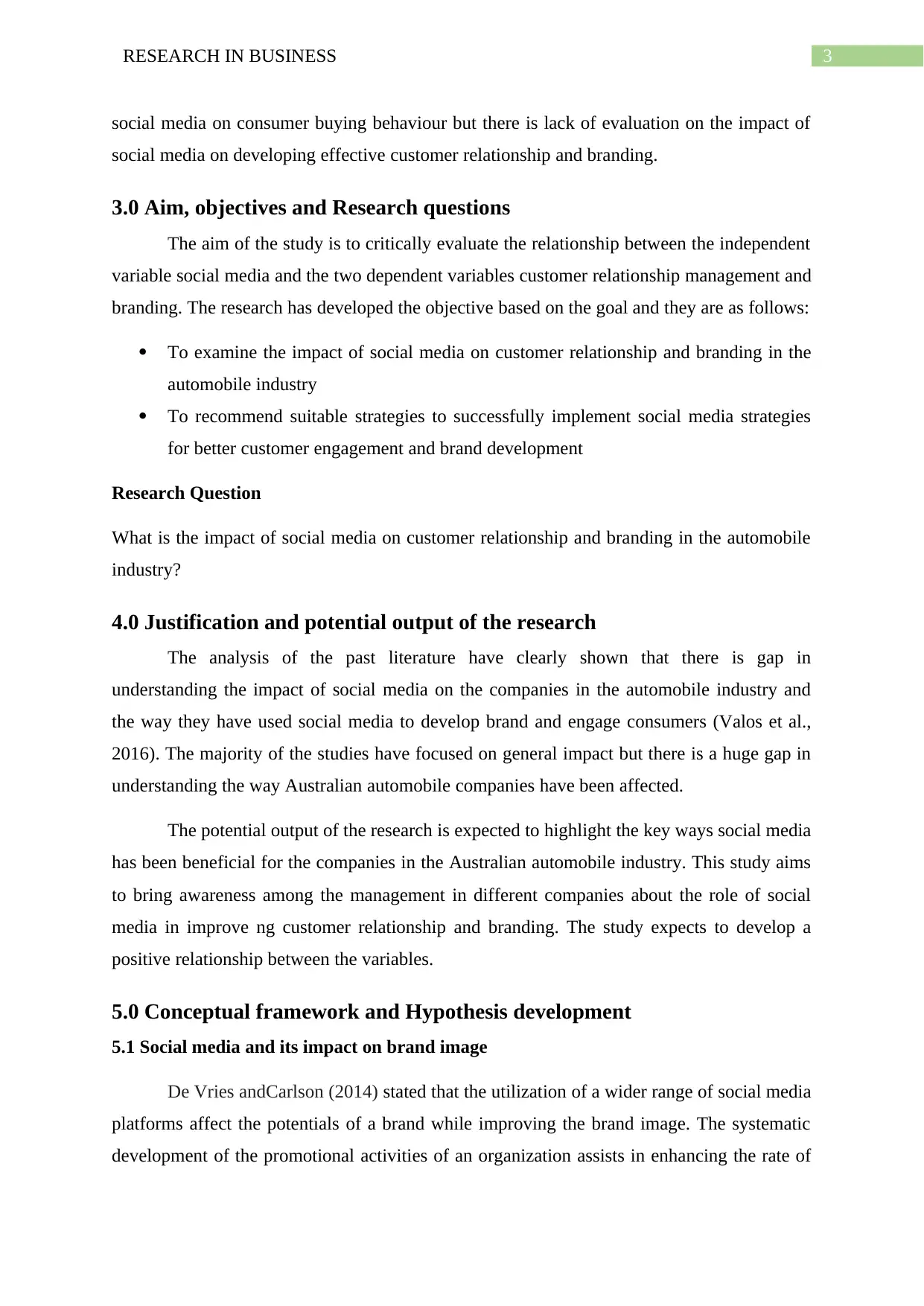
3RESEARCH IN BUSINESS
social media on consumer buying behaviour but there is lack of evaluation on the impact of
social media on developing effective customer relationship and branding.
3.0 Aim, objectives and Research questions
The aim of the study is to critically evaluate the relationship between the independent
variable social media and the two dependent variables customer relationship management and
branding. The research has developed the objective based on the goal and they are as follows:
To examine the impact of social media on customer relationship and branding in the
automobile industry
To recommend suitable strategies to successfully implement social media strategies
for better customer engagement and brand development
Research Question
What is the impact of social media on customer relationship and branding in the automobile
industry?
4.0 Justification and potential output of the research
The analysis of the past literature have clearly shown that there is gap in
understanding the impact of social media on the companies in the automobile industry and
the way they have used social media to develop brand and engage consumers (Valos et al.,
2016). The majority of the studies have focused on general impact but there is a huge gap in
understanding the way Australian automobile companies have been affected.
The potential output of the research is expected to highlight the key ways social media
has been beneficial for the companies in the Australian automobile industry. This study aims
to bring awareness among the management in different companies about the role of social
media in improve ng customer relationship and branding. The study expects to develop a
positive relationship between the variables.
5.0 Conceptual framework and Hypothesis development
5.1 Social media and its impact on brand image
De Vries andCarlson (2014) stated that the utilization of a wider range of social media
platforms affect the potentials of a brand while improving the brand image. The systematic
development of the promotional activities of an organization assists in enhancing the rate of
social media on consumer buying behaviour but there is lack of evaluation on the impact of
social media on developing effective customer relationship and branding.
3.0 Aim, objectives and Research questions
The aim of the study is to critically evaluate the relationship between the independent
variable social media and the two dependent variables customer relationship management and
branding. The research has developed the objective based on the goal and they are as follows:
To examine the impact of social media on customer relationship and branding in the
automobile industry
To recommend suitable strategies to successfully implement social media strategies
for better customer engagement and brand development
Research Question
What is the impact of social media on customer relationship and branding in the automobile
industry?
4.0 Justification and potential output of the research
The analysis of the past literature have clearly shown that there is gap in
understanding the impact of social media on the companies in the automobile industry and
the way they have used social media to develop brand and engage consumers (Valos et al.,
2016). The majority of the studies have focused on general impact but there is a huge gap in
understanding the way Australian automobile companies have been affected.
The potential output of the research is expected to highlight the key ways social media
has been beneficial for the companies in the Australian automobile industry. This study aims
to bring awareness among the management in different companies about the role of social
media in improve ng customer relationship and branding. The study expects to develop a
positive relationship between the variables.
5.0 Conceptual framework and Hypothesis development
5.1 Social media and its impact on brand image
De Vries andCarlson (2014) stated that the utilization of a wider range of social media
platforms affect the potentials of a brand while improving the brand image. The systematic
development of the promotional activities of an organization assists in enhancing the rate of
Paraphrase This Document
Need a fresh take? Get an instant paraphrase of this document with our AI Paraphraser
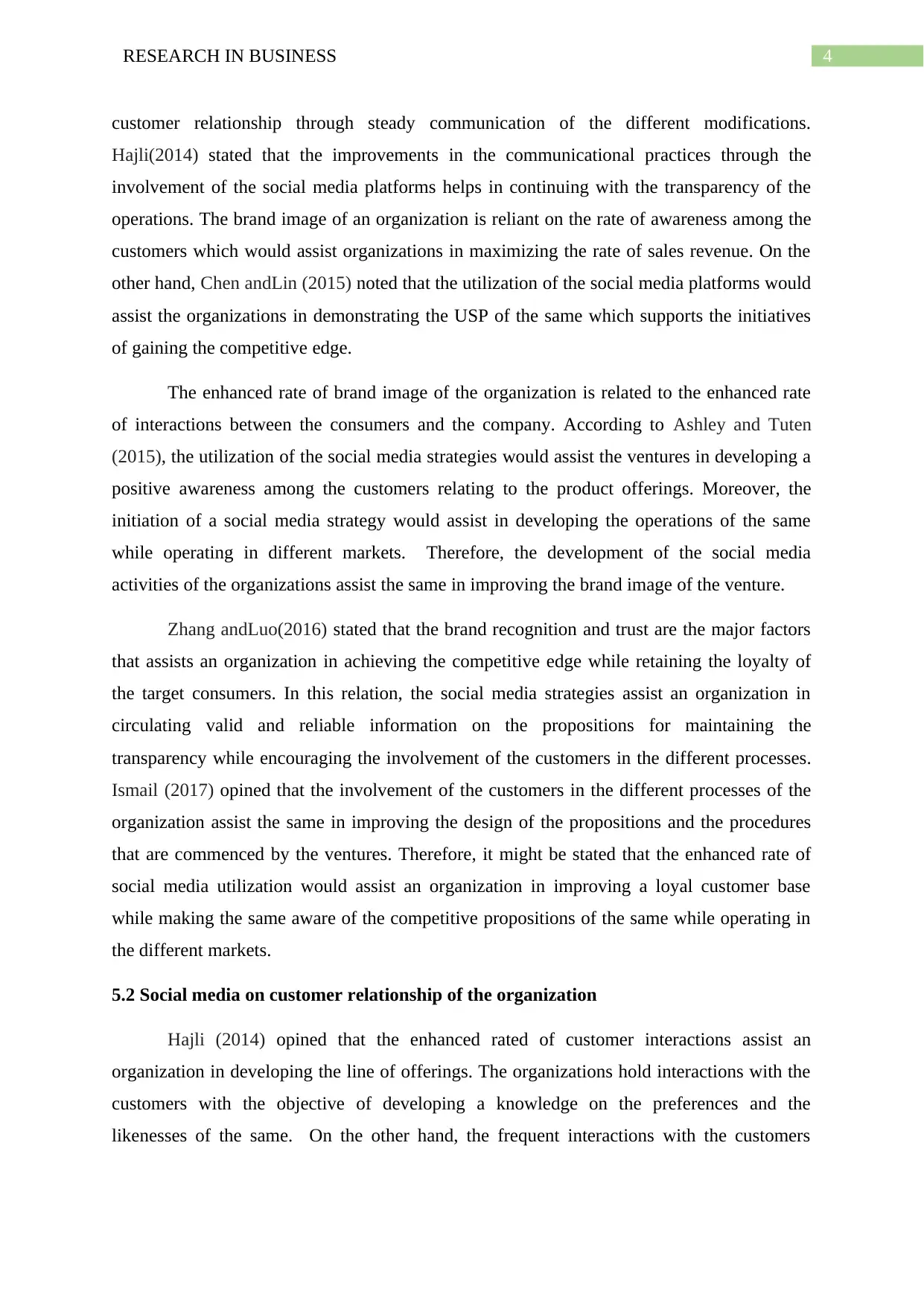
4RESEARCH IN BUSINESS
customer relationship through steady communication of the different modifications.
Hajli(2014) stated that the improvements in the communicational practices through the
involvement of the social media platforms helps in continuing with the transparency of the
operations. The brand image of an organization is reliant on the rate of awareness among the
customers which would assist organizations in maximizing the rate of sales revenue. On the
other hand, Chen andLin (2015) noted that the utilization of the social media platforms would
assist the organizations in demonstrating the USP of the same which supports the initiatives
of gaining the competitive edge.
The enhanced rate of brand image of the organization is related to the enhanced rate
of interactions between the consumers and the company. According to Ashley and Tuten
(2015), the utilization of the social media strategies would assist the ventures in developing a
positive awareness among the customers relating to the product offerings. Moreover, the
initiation of a social media strategy would assist in developing the operations of the same
while operating in different markets. Therefore, the development of the social media
activities of the organizations assist the same in improving the brand image of the venture.
Zhang andLuo(2016) stated that the brand recognition and trust are the major factors
that assists an organization in achieving the competitive edge while retaining the loyalty of
the target consumers. In this relation, the social media strategies assist an organization in
circulating valid and reliable information on the propositions for maintaining the
transparency while encouraging the involvement of the customers in the different processes.
Ismail (2017) opined that the involvement of the customers in the different processes of the
organization assist the same in improving the design of the propositions and the procedures
that are commenced by the ventures. Therefore, it might be stated that the enhanced rate of
social media utilization would assist an organization in improving a loyal customer base
while making the same aware of the competitive propositions of the same while operating in
the different markets.
5.2 Social media on customer relationship of the organization
Hajli (2014) opined that the enhanced rated of customer interactions assist an
organization in developing the line of offerings. The organizations hold interactions with the
customers with the objective of developing a knowledge on the preferences and the
likenesses of the same. On the other hand, the frequent interactions with the customers
customer relationship through steady communication of the different modifications.
Hajli(2014) stated that the improvements in the communicational practices through the
involvement of the social media platforms helps in continuing with the transparency of the
operations. The brand image of an organization is reliant on the rate of awareness among the
customers which would assist organizations in maximizing the rate of sales revenue. On the
other hand, Chen andLin (2015) noted that the utilization of the social media platforms would
assist the organizations in demonstrating the USP of the same which supports the initiatives
of gaining the competitive edge.
The enhanced rate of brand image of the organization is related to the enhanced rate
of interactions between the consumers and the company. According to Ashley and Tuten
(2015), the utilization of the social media strategies would assist the ventures in developing a
positive awareness among the customers relating to the product offerings. Moreover, the
initiation of a social media strategy would assist in developing the operations of the same
while operating in different markets. Therefore, the development of the social media
activities of the organizations assist the same in improving the brand image of the venture.
Zhang andLuo(2016) stated that the brand recognition and trust are the major factors
that assists an organization in achieving the competitive edge while retaining the loyalty of
the target consumers. In this relation, the social media strategies assist an organization in
circulating valid and reliable information on the propositions for maintaining the
transparency while encouraging the involvement of the customers in the different processes.
Ismail (2017) opined that the involvement of the customers in the different processes of the
organization assist the same in improving the design of the propositions and the procedures
that are commenced by the ventures. Therefore, it might be stated that the enhanced rate of
social media utilization would assist an organization in improving a loyal customer base
while making the same aware of the competitive propositions of the same while operating in
the different markets.
5.2 Social media on customer relationship of the organization
Hajli (2014) opined that the enhanced rated of customer interactions assist an
organization in developing the line of offerings. The organizations hold interactions with the
customers with the objective of developing a knowledge on the preferences and the
likenesses of the same. On the other hand, the frequent interactions with the customers
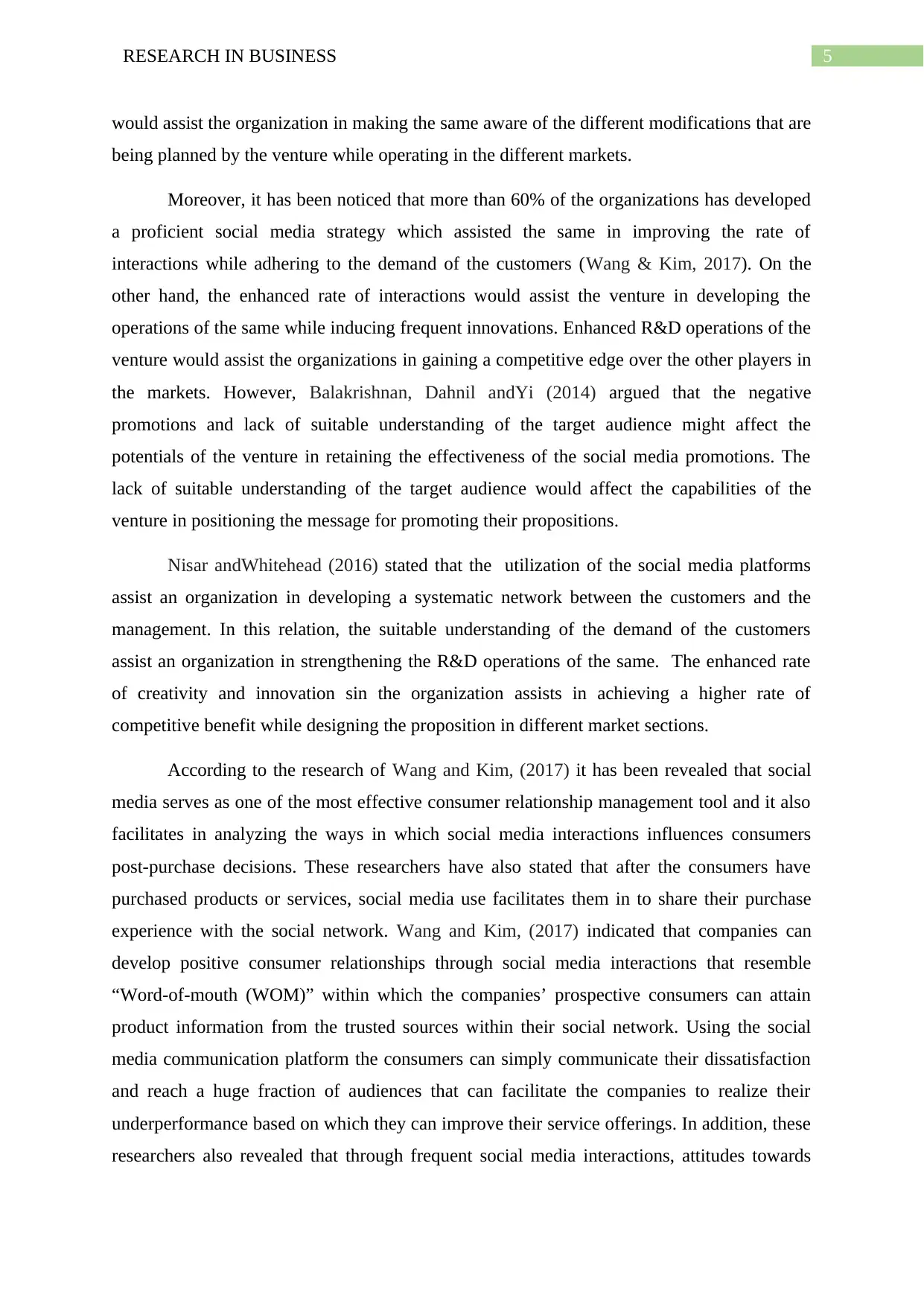
5RESEARCH IN BUSINESS
would assist the organization in making the same aware of the different modifications that are
being planned by the venture while operating in the different markets.
Moreover, it has been noticed that more than 60% of the organizations has developed
a proficient social media strategy which assisted the same in improving the rate of
interactions while adhering to the demand of the customers (Wang & Kim, 2017). On the
other hand, the enhanced rate of interactions would assist the venture in developing the
operations of the same while inducing frequent innovations. Enhanced R&D operations of the
venture would assist the organizations in gaining a competitive edge over the other players in
the markets. However, Balakrishnan, Dahnil andYi (2014) argued that the negative
promotions and lack of suitable understanding of the target audience might affect the
potentials of the venture in retaining the effectiveness of the social media promotions. The
lack of suitable understanding of the target audience would affect the capabilities of the
venture in positioning the message for promoting their propositions.
Nisar andWhitehead (2016) stated that the utilization of the social media platforms
assist an organization in developing a systematic network between the customers and the
management. In this relation, the suitable understanding of the demand of the customers
assist an organization in strengthening the R&D operations of the same. The enhanced rate
of creativity and innovation sin the organization assists in achieving a higher rate of
competitive benefit while designing the proposition in different market sections.
According to the research of Wang and Kim, (2017) it has been revealed that social
media serves as one of the most effective consumer relationship management tool and it also
facilitates in analyzing the ways in which social media interactions influences consumers
post-purchase decisions. These researchers have also stated that after the consumers have
purchased products or services, social media use facilitates them in to share their purchase
experience with the social network. Wang and Kim, (2017) indicated that companies can
develop positive consumer relationships through social media interactions that resemble
“Word-of-mouth (WOM)” within which the companies’ prospective consumers can attain
product information from the trusted sources within their social network. Using the social
media communication platform the consumers can simply communicate their dissatisfaction
and reach a huge fraction of audiences that can facilitate the companies to realize their
underperformance based on which they can improve their service offerings. In addition, these
researchers also revealed that through frequent social media interactions, attitudes towards
would assist the organization in making the same aware of the different modifications that are
being planned by the venture while operating in the different markets.
Moreover, it has been noticed that more than 60% of the organizations has developed
a proficient social media strategy which assisted the same in improving the rate of
interactions while adhering to the demand of the customers (Wang & Kim, 2017). On the
other hand, the enhanced rate of interactions would assist the venture in developing the
operations of the same while inducing frequent innovations. Enhanced R&D operations of the
venture would assist the organizations in gaining a competitive edge over the other players in
the markets. However, Balakrishnan, Dahnil andYi (2014) argued that the negative
promotions and lack of suitable understanding of the target audience might affect the
potentials of the venture in retaining the effectiveness of the social media promotions. The
lack of suitable understanding of the target audience would affect the capabilities of the
venture in positioning the message for promoting their propositions.
Nisar andWhitehead (2016) stated that the utilization of the social media platforms
assist an organization in developing a systematic network between the customers and the
management. In this relation, the suitable understanding of the demand of the customers
assist an organization in strengthening the R&D operations of the same. The enhanced rate
of creativity and innovation sin the organization assists in achieving a higher rate of
competitive benefit while designing the proposition in different market sections.
According to the research of Wang and Kim, (2017) it has been revealed that social
media serves as one of the most effective consumer relationship management tool and it also
facilitates in analyzing the ways in which social media interactions influences consumers
post-purchase decisions. These researchers have also stated that after the consumers have
purchased products or services, social media use facilitates them in to share their purchase
experience with the social network. Wang and Kim, (2017) indicated that companies can
develop positive consumer relationships through social media interactions that resemble
“Word-of-mouth (WOM)” within which the companies’ prospective consumers can attain
product information from the trusted sources within their social network. Using the social
media communication platform the consumers can simply communicate their dissatisfaction
and reach a huge fraction of audiences that can facilitate the companies to realize their
underperformance based on which they can improve their service offerings. In addition, these
researchers also revealed that through frequent social media interactions, attitudes towards
⊘ This is a preview!⊘
Do you want full access?
Subscribe today to unlock all pages.

Trusted by 1+ million students worldwide
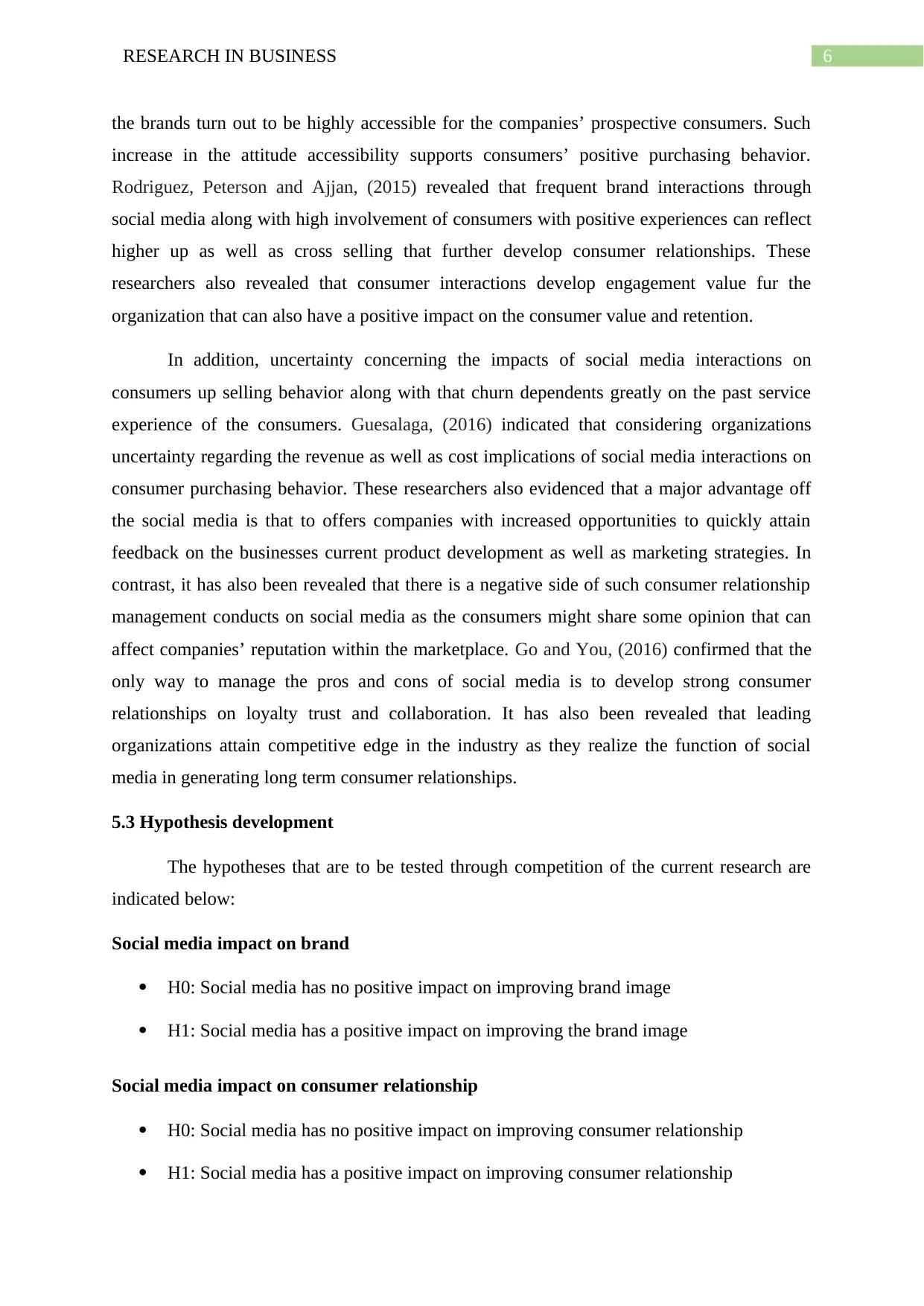
6RESEARCH IN BUSINESS
the brands turn out to be highly accessible for the companies’ prospective consumers. Such
increase in the attitude accessibility supports consumers’ positive purchasing behavior.
Rodriguez, Peterson and Ajjan, (2015) revealed that frequent brand interactions through
social media along with high involvement of consumers with positive experiences can reflect
higher up as well as cross selling that further develop consumer relationships. These
researchers also revealed that consumer interactions develop engagement value fur the
organization that can also have a positive impact on the consumer value and retention.
In addition, uncertainty concerning the impacts of social media interactions on
consumers up selling behavior along with that churn dependents greatly on the past service
experience of the consumers. Guesalaga, (2016) indicated that considering organizations
uncertainty regarding the revenue as well as cost implications of social media interactions on
consumer purchasing behavior. These researchers also evidenced that a major advantage off
the social media is that to offers companies with increased opportunities to quickly attain
feedback on the businesses current product development as well as marketing strategies. In
contrast, it has also been revealed that there is a negative side of such consumer relationship
management conducts on social media as the consumers might share some opinion that can
affect companies’ reputation within the marketplace. Go and You, (2016) confirmed that the
only way to manage the pros and cons of social media is to develop strong consumer
relationships on loyalty trust and collaboration. It has also been revealed that leading
organizations attain competitive edge in the industry as they realize the function of social
media in generating long term consumer relationships.
5.3 Hypothesis development
The hypotheses that are to be tested through competition of the current research are
indicated below:
Social media impact on brand
H0: Social media has no positive impact on improving brand image
H1: Social media has a positive impact on improving the brand image
Social media impact on consumer relationship
H0: Social media has no positive impact on improving consumer relationship
H1: Social media has a positive impact on improving consumer relationship
the brands turn out to be highly accessible for the companies’ prospective consumers. Such
increase in the attitude accessibility supports consumers’ positive purchasing behavior.
Rodriguez, Peterson and Ajjan, (2015) revealed that frequent brand interactions through
social media along with high involvement of consumers with positive experiences can reflect
higher up as well as cross selling that further develop consumer relationships. These
researchers also revealed that consumer interactions develop engagement value fur the
organization that can also have a positive impact on the consumer value and retention.
In addition, uncertainty concerning the impacts of social media interactions on
consumers up selling behavior along with that churn dependents greatly on the past service
experience of the consumers. Guesalaga, (2016) indicated that considering organizations
uncertainty regarding the revenue as well as cost implications of social media interactions on
consumer purchasing behavior. These researchers also evidenced that a major advantage off
the social media is that to offers companies with increased opportunities to quickly attain
feedback on the businesses current product development as well as marketing strategies. In
contrast, it has also been revealed that there is a negative side of such consumer relationship
management conducts on social media as the consumers might share some opinion that can
affect companies’ reputation within the marketplace. Go and You, (2016) confirmed that the
only way to manage the pros and cons of social media is to develop strong consumer
relationships on loyalty trust and collaboration. It has also been revealed that leading
organizations attain competitive edge in the industry as they realize the function of social
media in generating long term consumer relationships.
5.3 Hypothesis development
The hypotheses that are to be tested through competition of the current research are
indicated below:
Social media impact on brand
H0: Social media has no positive impact on improving brand image
H1: Social media has a positive impact on improving the brand image
Social media impact on consumer relationship
H0: Social media has no positive impact on improving consumer relationship
H1: Social media has a positive impact on improving consumer relationship
Paraphrase This Document
Need a fresh take? Get an instant paraphrase of this document with our AI Paraphraser
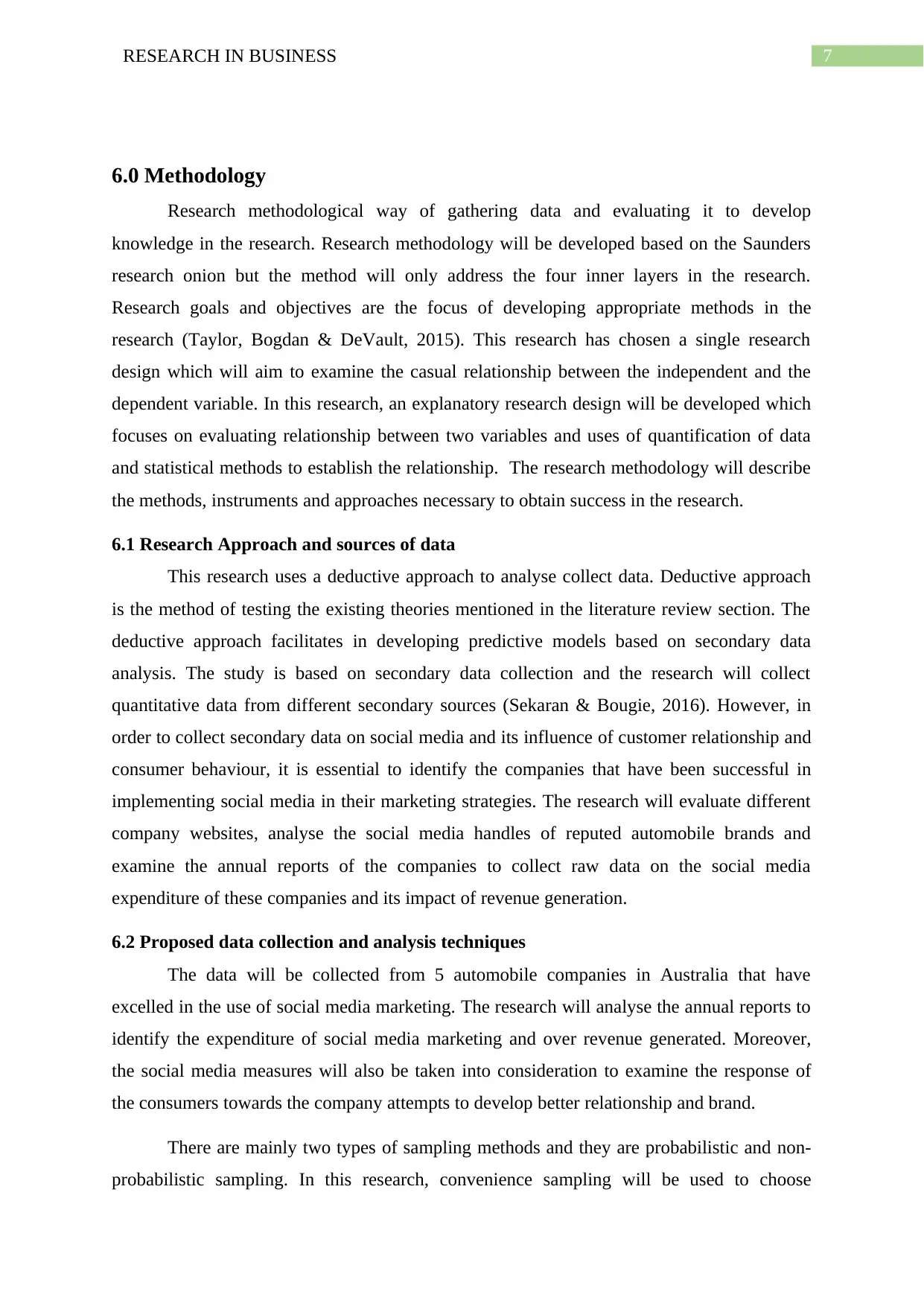
7RESEARCH IN BUSINESS
6.0 Methodology
Research methodological way of gathering data and evaluating it to develop
knowledge in the research. Research methodology will be developed based on the Saunders
research onion but the method will only address the four inner layers in the research.
Research goals and objectives are the focus of developing appropriate methods in the
research (Taylor, Bogdan & DeVault, 2015). This research has chosen a single research
design which will aim to examine the casual relationship between the independent and the
dependent variable. In this research, an explanatory research design will be developed which
focuses on evaluating relationship between two variables and uses of quantification of data
and statistical methods to establish the relationship. The research methodology will describe
the methods, instruments and approaches necessary to obtain success in the research.
6.1 Research Approach and sources of data
This research uses a deductive approach to analyse collect data. Deductive approach
is the method of testing the existing theories mentioned in the literature review section. The
deductive approach facilitates in developing predictive models based on secondary data
analysis. The study is based on secondary data collection and the research will collect
quantitative data from different secondary sources (Sekaran & Bougie, 2016). However, in
order to collect secondary data on social media and its influence of customer relationship and
consumer behaviour, it is essential to identify the companies that have been successful in
implementing social media in their marketing strategies. The research will evaluate different
company websites, analyse the social media handles of reputed automobile brands and
examine the annual reports of the companies to collect raw data on the social media
expenditure of these companies and its impact of revenue generation.
6.2 Proposed data collection and analysis techniques
The data will be collected from 5 automobile companies in Australia that have
excelled in the use of social media marketing. The research will analyse the annual reports to
identify the expenditure of social media marketing and over revenue generated. Moreover,
the social media measures will also be taken into consideration to examine the response of
the consumers towards the company attempts to develop better relationship and brand.
There are mainly two types of sampling methods and they are probabilistic and non-
probabilistic sampling. In this research, convenience sampling will be used to choose
6.0 Methodology
Research methodological way of gathering data and evaluating it to develop
knowledge in the research. Research methodology will be developed based on the Saunders
research onion but the method will only address the four inner layers in the research.
Research goals and objectives are the focus of developing appropriate methods in the
research (Taylor, Bogdan & DeVault, 2015). This research has chosen a single research
design which will aim to examine the casual relationship between the independent and the
dependent variable. In this research, an explanatory research design will be developed which
focuses on evaluating relationship between two variables and uses of quantification of data
and statistical methods to establish the relationship. The research methodology will describe
the methods, instruments and approaches necessary to obtain success in the research.
6.1 Research Approach and sources of data
This research uses a deductive approach to analyse collect data. Deductive approach
is the method of testing the existing theories mentioned in the literature review section. The
deductive approach facilitates in developing predictive models based on secondary data
analysis. The study is based on secondary data collection and the research will collect
quantitative data from different secondary sources (Sekaran & Bougie, 2016). However, in
order to collect secondary data on social media and its influence of customer relationship and
consumer behaviour, it is essential to identify the companies that have been successful in
implementing social media in their marketing strategies. The research will evaluate different
company websites, analyse the social media handles of reputed automobile brands and
examine the annual reports of the companies to collect raw data on the social media
expenditure of these companies and its impact of revenue generation.
6.2 Proposed data collection and analysis techniques
The data will be collected from 5 automobile companies in Australia that have
excelled in the use of social media marketing. The research will analyse the annual reports to
identify the expenditure of social media marketing and over revenue generated. Moreover,
the social media measures will also be taken into consideration to examine the response of
the consumers towards the company attempts to develop better relationship and brand.
There are mainly two types of sampling methods and they are probabilistic and non-
probabilistic sampling. In this research, convenience sampling will be used to choose
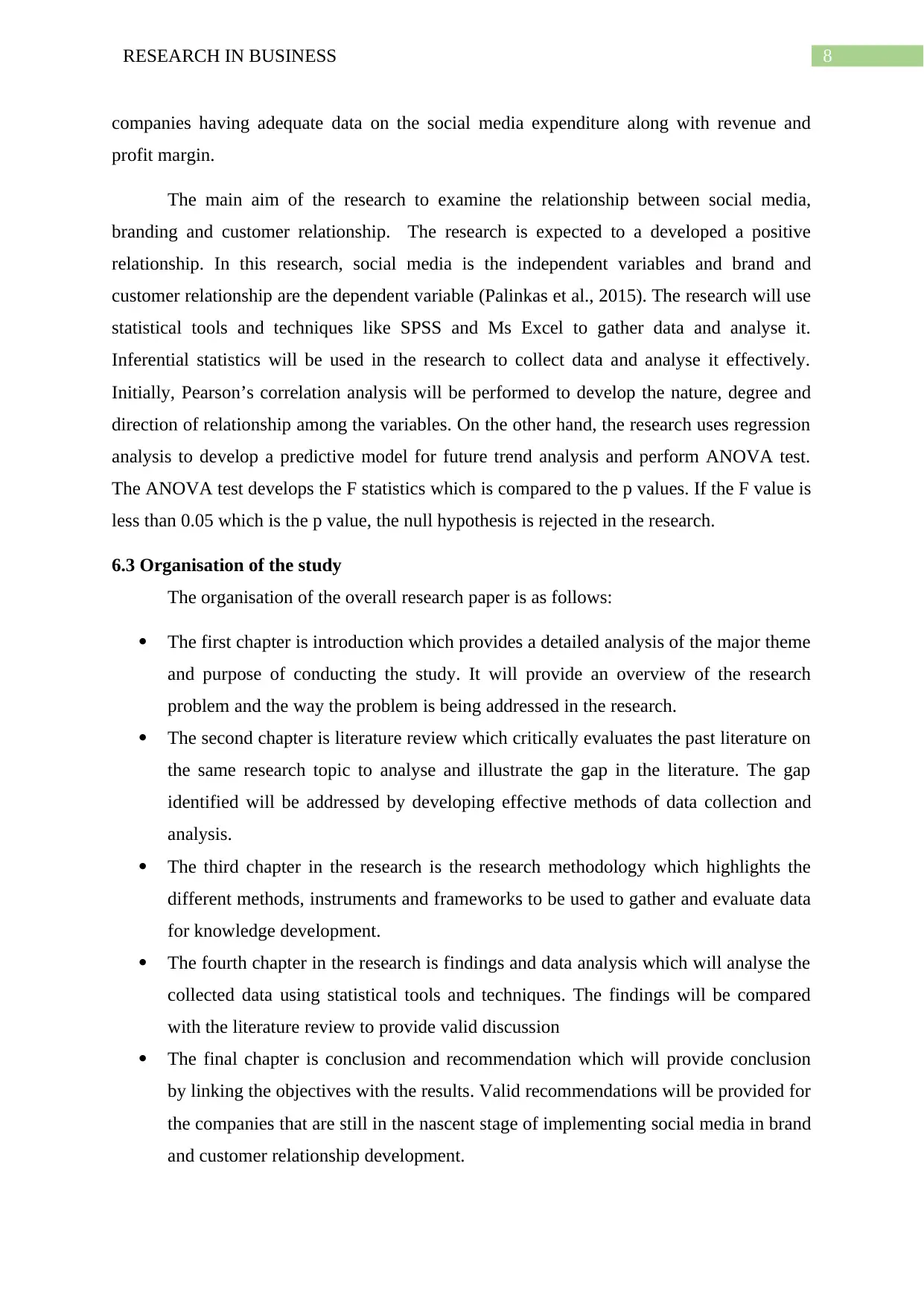
8RESEARCH IN BUSINESS
companies having adequate data on the social media expenditure along with revenue and
profit margin.
The main aim of the research to examine the relationship between social media,
branding and customer relationship. The research is expected to a developed a positive
relationship. In this research, social media is the independent variables and brand and
customer relationship are the dependent variable (Palinkas et al., 2015). The research will use
statistical tools and techniques like SPSS and Ms Excel to gather data and analyse it.
Inferential statistics will be used in the research to collect data and analyse it effectively.
Initially, Pearson’s correlation analysis will be performed to develop the nature, degree and
direction of relationship among the variables. On the other hand, the research uses regression
analysis to develop a predictive model for future trend analysis and perform ANOVA test.
The ANOVA test develops the F statistics which is compared to the p values. If the F value is
less than 0.05 which is the p value, the null hypothesis is rejected in the research.
6.3 Organisation of the study
The organisation of the overall research paper is as follows:
The first chapter is introduction which provides a detailed analysis of the major theme
and purpose of conducting the study. It will provide an overview of the research
problem and the way the problem is being addressed in the research.
The second chapter is literature review which critically evaluates the past literature on
the same research topic to analyse and illustrate the gap in the literature. The gap
identified will be addressed by developing effective methods of data collection and
analysis.
The third chapter in the research is the research methodology which highlights the
different methods, instruments and frameworks to be used to gather and evaluate data
for knowledge development.
The fourth chapter in the research is findings and data analysis which will analyse the
collected data using statistical tools and techniques. The findings will be compared
with the literature review to provide valid discussion
The final chapter is conclusion and recommendation which will provide conclusion
by linking the objectives with the results. Valid recommendations will be provided for
the companies that are still in the nascent stage of implementing social media in brand
and customer relationship development.
companies having adequate data on the social media expenditure along with revenue and
profit margin.
The main aim of the research to examine the relationship between social media,
branding and customer relationship. The research is expected to a developed a positive
relationship. In this research, social media is the independent variables and brand and
customer relationship are the dependent variable (Palinkas et al., 2015). The research will use
statistical tools and techniques like SPSS and Ms Excel to gather data and analyse it.
Inferential statistics will be used in the research to collect data and analyse it effectively.
Initially, Pearson’s correlation analysis will be performed to develop the nature, degree and
direction of relationship among the variables. On the other hand, the research uses regression
analysis to develop a predictive model for future trend analysis and perform ANOVA test.
The ANOVA test develops the F statistics which is compared to the p values. If the F value is
less than 0.05 which is the p value, the null hypothesis is rejected in the research.
6.3 Organisation of the study
The organisation of the overall research paper is as follows:
The first chapter is introduction which provides a detailed analysis of the major theme
and purpose of conducting the study. It will provide an overview of the research
problem and the way the problem is being addressed in the research.
The second chapter is literature review which critically evaluates the past literature on
the same research topic to analyse and illustrate the gap in the literature. The gap
identified will be addressed by developing effective methods of data collection and
analysis.
The third chapter in the research is the research methodology which highlights the
different methods, instruments and frameworks to be used to gather and evaluate data
for knowledge development.
The fourth chapter in the research is findings and data analysis which will analyse the
collected data using statistical tools and techniques. The findings will be compared
with the literature review to provide valid discussion
The final chapter is conclusion and recommendation which will provide conclusion
by linking the objectives with the results. Valid recommendations will be provided for
the companies that are still in the nascent stage of implementing social media in brand
and customer relationship development.
⊘ This is a preview!⊘
Do you want full access?
Subscribe today to unlock all pages.

Trusted by 1+ million students worldwide
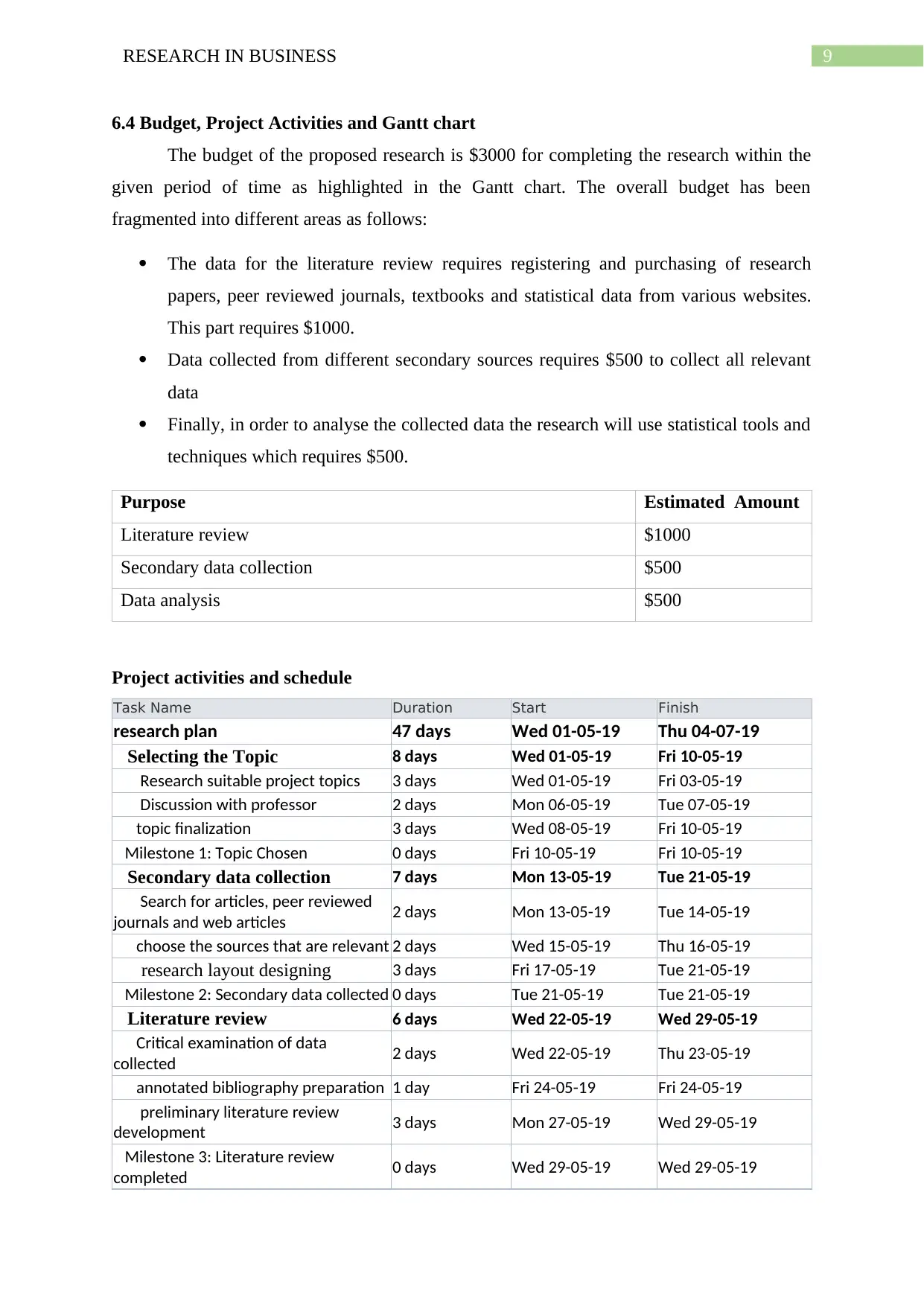
9RESEARCH IN BUSINESS
6.4 Budget, Project Activities and Gantt chart
The budget of the proposed research is $3000 for completing the research within the
given period of time as highlighted in the Gantt chart. The overall budget has been
fragmented into different areas as follows:
The data for the literature review requires registering and purchasing of research
papers, peer reviewed journals, textbooks and statistical data from various websites.
This part requires $1000.
Data collected from different secondary sources requires $500 to collect all relevant
data
Finally, in order to analyse the collected data the research will use statistical tools and
techniques which requires $500.
Purpose Estimated Amount
Literature review $1000
Secondary data collection $500
Data analysis $500
Project activities and schedule
Task Name Duration Start Finish
research plan 47 days Wed 01-05-19 Thu 04-07-19
Selecting the Topic 8 days Wed 01-05-19 Fri 10-05-19
Research suitable project topics 3 days Wed 01-05-19 Fri 03-05-19
Discussion with professor 2 days Mon 06-05-19 Tue 07-05-19
topic finalization 3 days Wed 08-05-19 Fri 10-05-19
Milestone 1: Topic Chosen 0 days Fri 10-05-19 Fri 10-05-19
Secondary data collection 7 days Mon 13-05-19 Tue 21-05-19
Search for articles, peer reviewed
journals and web articles 2 days Mon 13-05-19 Tue 14-05-19
choose the sources that are relevant 2 days Wed 15-05-19 Thu 16-05-19
research layout designing 3 days Fri 17-05-19 Tue 21-05-19
Milestone 2: Secondary data collected 0 days Tue 21-05-19 Tue 21-05-19
Literature review 6 days Wed 22-05-19 Wed 29-05-19
Critical examination of data
collected 2 days Wed 22-05-19 Thu 23-05-19
annotated bibliography preparation 1 day Fri 24-05-19 Fri 24-05-19
preliminary literature review
development 3 days Mon 27-05-19 Wed 29-05-19
Milestone 3: Literature review
completed 0 days Wed 29-05-19 Wed 29-05-19
6.4 Budget, Project Activities and Gantt chart
The budget of the proposed research is $3000 for completing the research within the
given period of time as highlighted in the Gantt chart. The overall budget has been
fragmented into different areas as follows:
The data for the literature review requires registering and purchasing of research
papers, peer reviewed journals, textbooks and statistical data from various websites.
This part requires $1000.
Data collected from different secondary sources requires $500 to collect all relevant
data
Finally, in order to analyse the collected data the research will use statistical tools and
techniques which requires $500.
Purpose Estimated Amount
Literature review $1000
Secondary data collection $500
Data analysis $500
Project activities and schedule
Task Name Duration Start Finish
research plan 47 days Wed 01-05-19 Thu 04-07-19
Selecting the Topic 8 days Wed 01-05-19 Fri 10-05-19
Research suitable project topics 3 days Wed 01-05-19 Fri 03-05-19
Discussion with professor 2 days Mon 06-05-19 Tue 07-05-19
topic finalization 3 days Wed 08-05-19 Fri 10-05-19
Milestone 1: Topic Chosen 0 days Fri 10-05-19 Fri 10-05-19
Secondary data collection 7 days Mon 13-05-19 Tue 21-05-19
Search for articles, peer reviewed
journals and web articles 2 days Mon 13-05-19 Tue 14-05-19
choose the sources that are relevant 2 days Wed 15-05-19 Thu 16-05-19
research layout designing 3 days Fri 17-05-19 Tue 21-05-19
Milestone 2: Secondary data collected 0 days Tue 21-05-19 Tue 21-05-19
Literature review 6 days Wed 22-05-19 Wed 29-05-19
Critical examination of data
collected 2 days Wed 22-05-19 Thu 23-05-19
annotated bibliography preparation 1 day Fri 24-05-19 Fri 24-05-19
preliminary literature review
development 3 days Mon 27-05-19 Wed 29-05-19
Milestone 3: Literature review
completed 0 days Wed 29-05-19 Wed 29-05-19
Paraphrase This Document
Need a fresh take? Get an instant paraphrase of this document with our AI Paraphraser
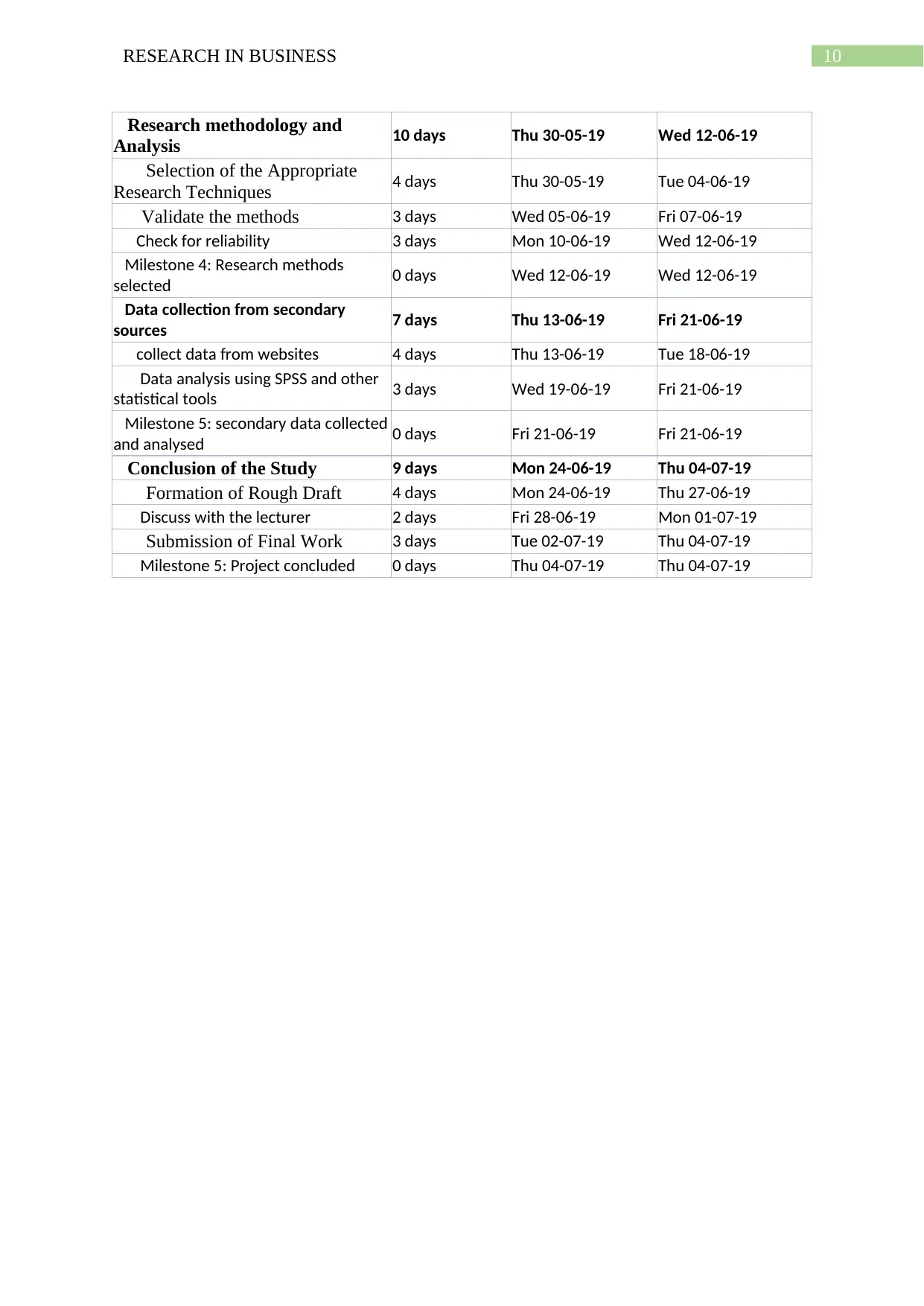
10RESEARCH IN BUSINESS
Research methodology and
Analysis 10 days Thu 30-05-19 Wed 12-06-19
Selection of the Appropriate
Research Techniques 4 days Thu 30-05-19 Tue 04-06-19
Validate the methods 3 days Wed 05-06-19 Fri 07-06-19
Check for reliability 3 days Mon 10-06-19 Wed 12-06-19
Milestone 4: Research methods
selected 0 days Wed 12-06-19 Wed 12-06-19
Data collection from secondary
sources 7 days Thu 13-06-19 Fri 21-06-19
collect data from websites 4 days Thu 13-06-19 Tue 18-06-19
Data analysis using SPSS and other
statistical tools 3 days Wed 19-06-19 Fri 21-06-19
Milestone 5: secondary data collected
and analysed 0 days Fri 21-06-19 Fri 21-06-19
Conclusion of the Study 9 days Mon 24-06-19 Thu 04-07-19
Formation of Rough Draft 4 days Mon 24-06-19 Thu 27-06-19
Discuss with the lecturer 2 days Fri 28-06-19 Mon 01-07-19
Submission of Final Work 3 days Tue 02-07-19 Thu 04-07-19
Milestone 5: Project concluded 0 days Thu 04-07-19 Thu 04-07-19
Research methodology and
Analysis 10 days Thu 30-05-19 Wed 12-06-19
Selection of the Appropriate
Research Techniques 4 days Thu 30-05-19 Tue 04-06-19
Validate the methods 3 days Wed 05-06-19 Fri 07-06-19
Check for reliability 3 days Mon 10-06-19 Wed 12-06-19
Milestone 4: Research methods
selected 0 days Wed 12-06-19 Wed 12-06-19
Data collection from secondary
sources 7 days Thu 13-06-19 Fri 21-06-19
collect data from websites 4 days Thu 13-06-19 Tue 18-06-19
Data analysis using SPSS and other
statistical tools 3 days Wed 19-06-19 Fri 21-06-19
Milestone 5: secondary data collected
and analysed 0 days Fri 21-06-19 Fri 21-06-19
Conclusion of the Study 9 days Mon 24-06-19 Thu 04-07-19
Formation of Rough Draft 4 days Mon 24-06-19 Thu 27-06-19
Discuss with the lecturer 2 days Fri 28-06-19 Mon 01-07-19
Submission of Final Work 3 days Tue 02-07-19 Thu 04-07-19
Milestone 5: Project concluded 0 days Thu 04-07-19 Thu 04-07-19
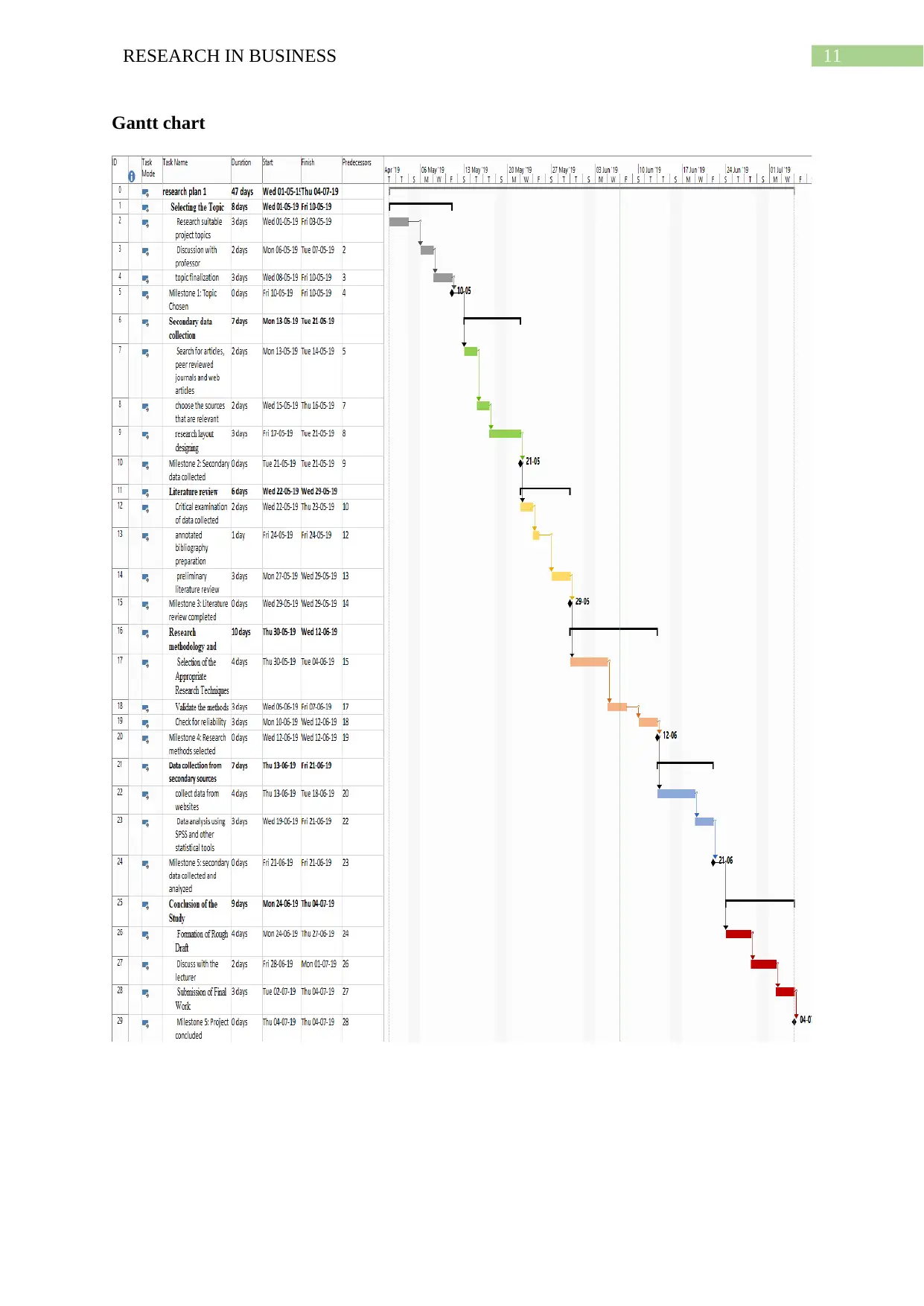
11RESEARCH IN BUSINESS
Gantt chart
Gantt chart
⊘ This is a preview!⊘
Do you want full access?
Subscribe today to unlock all pages.

Trusted by 1+ million students worldwide
1 out of 15
Related Documents
Your All-in-One AI-Powered Toolkit for Academic Success.
+13062052269
info@desklib.com
Available 24*7 on WhatsApp / Email
![[object Object]](/_next/static/media/star-bottom.7253800d.svg)
Unlock your academic potential
Copyright © 2020–2025 A2Z Services. All Rights Reserved. Developed and managed by ZUCOL.





